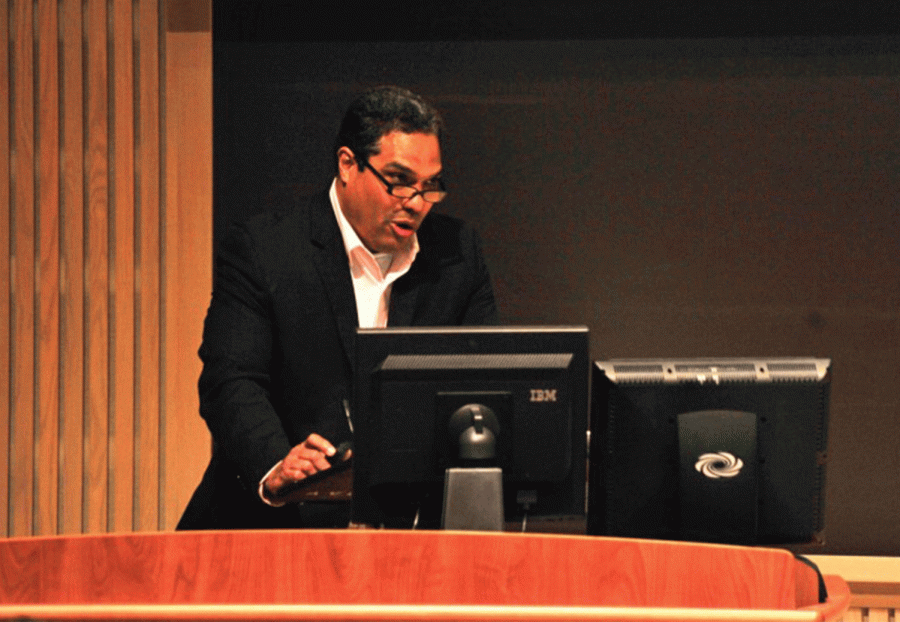Brothers Hosts Lecture About Colorblind Racism
On Thursday, November 6, Brothers sponsored a lecture by Chair of the Sociology department at Duke University Professor Eduardo Bonilla Silva, titled “Colorblind Racism and the Latin Americanization of Race Stratification in the United States.” The lecture dealt with a variety of different types of race-based discrimination and stereotyping that affect minorities in less obvious ways than overt racial slander. Throughout his lecture Silva used humor as he spoke about some the various issues of racism in America.
“I thought he was very humorous, especially as he was dealing with what can sometimes be a very serious topic,” first-year Lesther Flores said.
Silva began his lecture by vowing to challenge the contemporary idea that racism has declined in significance and that racial minorities are perpetuate discrimination because they supposedly make every issue about race. Silva explained that although racism has changed in form, it is still very real and affects everyone’s lives.
The lecture was separated into four parts: explaining what racism is, describing the dominant form of discrimination in the post-civil-rights era, illustrating the method of racial discourse since the 1970s and finally outlining what needs to be done to end racism.
Silva outlined how oftentimes when people think of racism they think of the Ku Klux Klan, neo-Nazis and people like Cliven Bundy. He said these examples represented only a small portion of a much larger topic we should be talking about. Silva explained that talking about these examples as if they are what racism is all about masks the idea that racism is a larger social structure in which everyone participates, whether consciously or not. It also causes people to miss most racism present in today’s society, that is not as overt or obvious if one is not directly experiencing it.
Silva argued that in the post-civil-rights-era racism has begun to take the form of methods that are much harder to track like housing discrimination, neighborhood associations, job discrimination and racist loan practices like redlining. Silva argued that even now, 40 years after the beginning of the post-civil-rights era, America is still almost as segregated as it was back in 1960s as a direct result of housing discrimination against minority groups. He also noted that this segregation helps to make other form of structural racism easier, such as banks giving more expensive loans to people who live in certain areas–a practice he called redlining. Silva described an experiment conducted by sociologists that revealed that people with very similar profiles who were of different races often had very different experiences when buying a house. They found that 50 percent of the time for black or hispanic testers they would be given different information from realtors about a house and its availability. Silva described this as the nature of today’s racism–it is often undetectable and very difficult to prosecute because it is so hard to see.
“The nasty racial discourse of the past has been for the most part replaced by a more civilized racism that I label colorblind racism,” Silva said.
He argued that the new dominant discourse argues that racism does not exist and attaches several non-race factors to issues about race. Silva used several real-world examples of people who were asked questions about race and showed how they attributed many of the patterns of discrimination in today’s society to non-racial factors. He showed an example of someone who opposed affirmative action because the individual believed that people should be given jobs based on their merit and not because they are of an underrepresented group. Silva followed by showing an experiment in which experimenters created two fabricated resumes and sent them out to employers. The only difference on the resumes was that one person had a supposedly traditional black name, “Tyrone,” and the other had a supposedly white name, “Brett.” He noted that in this first stage of resume reviews, Brett was far more likely to get a call back than Tyrone.
When the experimenters added a criminal record to Brett’s resume, Brett still received more callbacks than Tyrone did. The experiment shows that minorities with better qualifications are sometimes overlooked on the job market. Silva noted that while the politics of Affirmative Action can sometimes be very complex, this experiment illustrates why it is necessary until the larger problems of racism in society are fixed.
“I thought it was really interesting how he brought up something like affirmative action and made it clear that while it can definitely be viewed as a racist institution, it is in fact a response to the racist institution that is the society that we live in today,” first-year student and member of Brothers Andrew Vallejos said.
Finally, Silva noted that the way to stop racism is to teach anyone who will listen about the true nature of racism, revealing that racism is not about good and bad people but rather an institution that benefits some people to the detriment of others based on race.
Sophomore Manuel Medina was one of the main organizers of the event who felt like Silva was able to convey an important message to the audience.
“The audience members were able to capture his message without having to go through the 300 pages of reading that I had to do. While the lecture gives the students less time to engage with the material and ponder on the text, it gives students the language to engage in these conversations with others,” Medina said.







